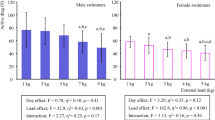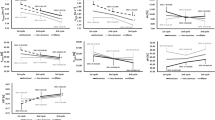Summary
The passive drag (Dp) of 218 competitive swimmers was studied and related to their performance level. To study this relationship, specific attention was given to anthropometric and joint laxity (JL) variations. The Dp was measured at 1.40 m·s−1, using a mechanical winch and a strain gauge with a load cell connected to a strain bridge. Swimmers were towed in a prone position holding their breath after a maximal inspiration. Buoyancy was evaluated by the hydrostatic lift (HL), i.e. the maximal weight just necessary to maintain the swimmer in a balanced position under the water after a maximal inspiration. The JL was assessed by a standard scoring system. The Dp was related mainly to the surface area (SA) (r=0.73 and 0.53;P<0.01, for males and females respectively). For a given SA, Dp was inversely related to the performance level. The JL explained 7% of the variability of Dp. On average, Dp measured, after a maximal expiration, increases of about 22% SD 3% (P<0.01). This increase was related to individual vital capacities (r=0.86,P<0.01). As Dp was mainly related to SA and HL, it is suggested that the body exerts a large pressure effect on the water. The contribution to performance might be related to the gliding phase of swimming.
Similar content being viewed by others
References
d'Acquisto LJ, Costill DL, Gehlsen GM, Wong-Tai Young, Lee G (1988) Breaststroke economy skill and performance: study of breaststroke mechanics using a computer based “velocity video”. J Swimming Res 4:9–14
Bloomfield J, Blankby BA, Beard DF, Ackland TR, Elliott BC (1984) Biological characteristics of young swimmers, tennis players and non-competitors. Br J Sports Med 18:97–103
Brodie DA, Bird HA, Wright V (1982) Joint laxity in selected athletic populations. Med Sci Sports Exerc 14:190–193
Carter C, Wilkinson J (1964) Persistent joint laxity and congenital dislocation of the hip. J Bone Joint Surg 46B:40–45
Charbonnier JP, Lacour JR, Riffat J, Flandrois R (1975) Experimental study of the performance of competition swimmers. Eur J Applied Physiol 34:157–167
Chatard JC, Padilla S, Paulin M, Lacour JR (1985) Some features of the 400-m free style Olympic record holder. NZ J Sports Med 13:114–116
Clarys JP (1979) Human morphology and hydrodynamics. In: Terauds J, Bedingfield EW (eds) Swimming III. University Park Press, Baltimore, pp 3–44
Councilman JE (1955) Forces in swimming two types of crawl stroke. Res Q 26:127–139
Cureton TK (1975) Factors governing success in competitive swimming: a brief review of related studies. In: Lewillie L, Clarys JP (eds) Swimming II. University Park Press, Baltimore, pp 9–41
Daly D, Persyn U, Tilborgh L van, Riemaker D (1988) Estimation of sprint performances in the breaststroke from body characteristics. In: Ungerechts BE, Wilke K, Reischle K (eds) Swimming science V. Human Kinetics, Champain, Ill. pp 101–107
Du Bois D, Du Bois EF (1916) Clinical calorimetry. A formula to estimate the approximate surface area if height and weight be known. Arch Intern Med 17:863–871
Hollander AP, Groot G de, Ingen Schenau GJ van, Toussaint HM, Best M de, Peters W, Meulemans A, Schreurs AW (1986) Measurement of active drag during crawl arm stroke swimming. Eur J Appl Physiol 33:95–103
Holmer I (1974) Physiology of swimming man. Acta Physiol Scand [Suppl] 407:1–55
Karpovich PV (1933) Water resistance in swimming. Res Q 4:21–28
Manen JD van, Rijken H (1975) Dynamic measurement techniques on swimming body at the Nederlands Ship Model Basin. In: Lewillie L, Clarys JP (eds) Swimming II. University Park Press, Baltimore, pp 70–79
Miyashita M, Tsunoda T (1978) Water resistance in relation to body size. In: Terauds J, Beringfield EW (eds) Swimming medicine III. University Park Press, Baltimore, pp 395–401
Pendergast DR, Prampero PE di, Craig AB, Wilson DR, Rennie DW (1977) Quantitative analysis of the front crawl in men and women. J Appl Physiol 43:475–479
Prampero PE di, Pendergast DR, Wilson DR, Rennie DW (1974) Energetics of swimming in man. J Appl Physiol 37:1–5
Schleihauf R, Gray L, Rose J de (1983) Three dimensional analysis of hand propulsion in the sprint front crawl stroke. In: Hollander AP, Huijing PA, Groot G de (eds) Biomechanics and medicine in swimming. Human Kinetics, Champaign, Ill., pp 173–183
Tilborgh L, Daly D, Persyn V (1983) The influence of some somatic factors on passive drag, gravity and buoyancy forces in competitive swimmers. In: Hollander AP, Huijing PA, de Groot G (eds) Biomechanics and medicine in swimming. Human Kinetics, Champaign Ill., pp 207–214
Vaart AJ van der, Savelberg HH, Groot G de, Hollander AP, Toussaint HM, Ingen Schenau GJ van (1987) Estimation of drag in front crawl swimming. J Biomech 20:543–546
Author information
Authors and Affiliations
Rights and permissions
About this article
Cite this article
Chatard, J.C., Bourgoin, B. & Lacour, J.R. Passive drag is still a good evaluator of swimming aptitude. Europ. J. Appl. Physiol. 59, 399–404 (1990). https://doi.org/10.1007/BF02388619
Accepted:
Issue Date:
DOI: https://doi.org/10.1007/BF02388619




